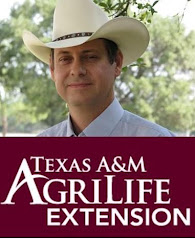The recent rainfall has offered forage producers some alternatives if they wish to establish winter pastures. Although cool-season annual forages can be expensive to plant and grow, they
can be a less costly substitute for supplements found in a bale, sack, or tub. There are several options when it comes to a cool-season forage, and all have different pros and cons.
Oat is the least winter-hardy cool-season annual grass, but for South Texas, this would be a good choice, since hard freezes are not common. Oats can be planted in early fall and will more than likely produce the most early dry matter of the cool-season forages in South Texas. Keep in mind that forage production can be variable with oats and oats do not grow well on sandy soils, but tolerate wet, poorly drained soils better than other small grains.
Rye is the most winter hardy of the annual winter pasture grasses. Compared to other annual winter grasses, rye produces more fall and winter forage. It matures earlier in the spring than most wheat varieties - usually peaking in early Spring. Rye grows well on well-drained soils that are sandy in texture.
Wheat provides the most flexibility as a crop as it can serve as a forage crop and grain crop simultaneously, if managed properly. It produces well on a wide range of soils, with very sandy soils being the exception. One negative aspect of wheat is that most of the production occurs in the Spring.
Barley and Triticale are cool-season annual grasses which are not as widely used. Barley is most noted for being tolerant of saline and alkaline soils. It does not grow well on sandy soils, but is drought tolerant. Triticale is a "cross" between wheat and rye and its forage production generally exceeds that of wheat. Triticale has characteristics of both parental lines that may make it the most widely adapted of the small grains.
Ryegrass is adapted to a wide range of soil types, growing better on wet soils than most other cool-season annual grasses. It can be easily established by simply broadcasting seed on the soil surface or on grass sod, but establishes better if a light disking operation on a short sod is performed prior to broadcasting the seed. Production of dry matter from ryegrass will be late in the cool season; therefore, most ryegrass forage will generally be available later than the small grains. This is an advantage of ryegrass because mixtures of small grains with ryegrass can work well to extend the grazing season.
Legumes like burr medics and clovers are good for the soil and provide good nutrition for livestock; however, their dry matter production will be late in the cool season, most of which will occur in early Spring. Cool-season legumes are an attractive option to decrease the production cost associated with nitrogen fertilization because legumes have the ability to fix atmospheric N. Annual clovers can contribute about 75- 100 lbs N/acre for the subsequent grass crop. They are, however, only able to fix N from the air if host-specific strains of Rhizobia bacteria are present in nodules on their roots.
In South Texas, the general recommendation is to overseed cool-season annual
forages from 6 to 8 weeks before the average first killing frost. Correct timing for cool-season
annual forage establishment cannot be overemphasized. If planted too early, warm temperatures and the competitive nature of the warm-season perennial grass sod can result in stand failure.
Planting cool-season forages with a drill is usually better than broadcasting as more of the seed is placed at the proper depth. When broadcasted, the seeding rates should be increased 25 to 30% to compensate for fewer seed becoming established plants. Small grains should be planted
from 1 to 1.5 inches deep, and ryegrass should be planted approximately 1/8 to 1/4
inches deep. Clovers and medics have very small seed and should be either planted 1/8 to ¼ inches deep or broadcast on the soil surface and rolled. Seeding rates for cool-season small grains range from 90-120 pounds per acre, while ryegrass seeding rates range from 25-30 pounds per acre and clovers and medics range from 4-16 pounds per acre.
Fertilization for cool-season forages should be based on soil test recommendation and
fertilizer should be applied at planting or after emergence, except for phosphorus, which
should be applied several weeks ahead of the anticipated planting date. Nitrogen fertilization of
over-seeded small grains or ryegrass is usually split into two applications of 50 to 60 lbs/acre each. If ryegrass is planted in combination with a small grain, one to two additional applications of N will be required. The initial N application on small grains should be delayed until after the small grain is established and cool temperatures have reduced warm-season grass growth. For ryegrass-only pastures, the first N application should not be applied until mid January and then again approximately six weeks later.
Although winter pastures provide forage that is high in nutritive value, establishment
and maintenance costs are relatively high. Therefore, winter pastures containing small grains
should be carefully managed to maximize the return on the investment, and one more thing, we have to have rain to make this system work.
Variety test information is available at
http://varietytesting.tamu.edu/


















